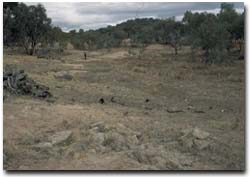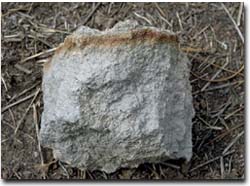Pedogenic Hardpans in North East Victoria
Hardpans in Victoria | Hardpans in the Wodonga-Tallangatta Region | References
Background
This information was derived from Rowe's (1994) PhD thesis which was based on research carried out in the Geography and Environmental Sciences Department at Monash University. This research examined the potential influence of aridity associated with past glacial periods on some soils in north-eastern Victoria.
The two principal themes included:
(i) the contribution of wind-transported sediments to the parent materials of these soils,
(ii) the affects of desiccation on surface soil during those periods which resulted in the formation of consolidated and cracked material layers. These subsequently became indurated as the weathering of alumino-silicate minerals released silica to form the hardpans which are found in some present day soils.
Introduction
There are two widely recognised forms of pedogenic hardpan that have been defined by American Soil Survey Staff (1990):
- Duripans are hard, subsurface horizons, cemented by silica or other materials such as iron oxides or calcium carbonate to the extent that fragments of the air-dry material will not slake after prolonged soaking in water or in HCl. They have very firm or extremely firm consistence when moist and are always brittle, even after prolonged wetting.
- Fragipans are seemingly cemented, with hard to very hard consistence when dry and moderate to weak brittleness when moist. A dry fragment slakes or fractures when placed in water.
Silcrete is one of the more widely distributed forms of hardpan and has been the subject of considerable research since the material was identified and described by Lamplugh (1902), and a great deal of this research has been carried out within Australia (Williamson 1957; Stephens 1961; Callender 1978; Langford-Smith 1978; Milnes and Twidale 1983; Milnes et al. 1991). Other forms of duripan, such as the Wiluna Hardpan, a red-brown hardpan from arid Australia (Betteny and Churchward 1974) and the Yuleba Hardpan of South Eastern Queensland (Van Dijk and Beckman 1978), are generally considered to be distinctly different from silcrete (Stephens 1961; Milnes et al. 1991). Brewer et al. (1972) concluded that the formation of the Wiluna Hardpan involved silicification processes interspersed with episodes of clay illuviation. They suggested that the hardpan material had originally been relatively permeable before clay was introduced by illuviation, and that silicification probably occurred during the formation of the overlying soil profiles.
Hardpan horizons in north-western New South Wales were found to consist of a wide range of constituent materials cemented by alternating deposition of silica, clay and carbonates (Chartres 1985).
Amorphous silica was identified as the major cementing agent in some duripans as well as indurated granite-saprolite (Chartres and Fitzgerald 1990). They proposed that in hardsetting E-horizons, silica and aluminium mobilised during weathering and precipitated as the soil dried out in spring and summer. This appeared to form temporary soil-cementing agents. These authors demonstrated the significance of silica and associated materials as chemical cementing agents over a wide range of environmental conditions.
| Fragipans have not attracted much research attention in Australia but have been widely studied in the northern hemisphere where they are often formed under the influence of subsoil freezing associated with periglacial environments (Fitzpatrick 1956; Crampton 1985). Fragipans formed in this way typically have a platy structure which is attributed to pressure generated by ice formation within a permafrost layer. Alternative hypotheses which do not require a periglacial environment have been proposed (Bryant 1989; Smeck et al. 1989). Smeck et al. (1989) suggested a range of processes which could contribute to fragipan characteristics including:
|  Exposed hardpan material at the base of a slope near Chiltern. |
Although hardsetting soils are not generally considered to be either duripans or fragipans they have sometimes been included in hardpan studies to examine their similarities and to compare the processes involved Chartres and Norton (1994). Chartres et al. (1990) found that the strength of hardsetting soils appeared to result from a combination of:
Chartres and Norton (1994) arrived at similar conclusions concerning the nature of the cementing agents in several hardsetting horizons and a duric horizon. However, they found that the former contained considerably less silica-rich bridging materials and evidence of silica precipitation, than the duripan samples examined. |  Close up of a duripan near Chiltern. |


